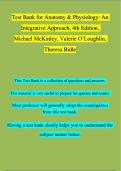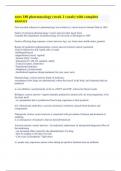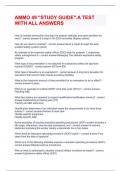Test Bank for Anatomy & Physiology: An
Integrative Approach, 4th Edition,
Michael McKinley, Valerie O’Loughlin,
Theresa Bidle
This Test Bank is a collection of questions and answers.
This material is very useful to prepare for quizzes and exams.
Most professor will generally adopt the exam/quizzes
from this test bank.
Having a test bank clearly helps you to understand the
subject matter better.
,Test Bank for Anatomy & Physiology: An Integrative Approach, 4th Edition, Michael
McKinley, Valerie O’Loughlin, Theresa Bidle, ISBN10: 1260265218, ISBN13:
9781260265217
Table of Contents
1. The Sciences of Anatomy and Physiology
2. Atoms, Ions, and Molecules
3. Energy, Chemical Reactions, and Cellular Respiration
4. Biology of the Cell
5. Tissue Organization
6. Integumentary System
7. Skeletal System: Bone Structure and Function
8. Skeletal System: Axial and Appendicular Skeleton
9. Skeletal System: Articulations
10. Muscle Tissue
11. Muscular System: Axial and Appendicular Muscles
12. Nervous System: Nervous Tissue
13. Nervous System: Brain and Cranial Nerves
14. Nervous System: Spinal Cord and Spinal Nerves
15. Nervous System: Autonomic Nervous System
16. Nervous System: Senses
17. Endocrine System
18. Cardiovascular System: Blood
19. Cardiovascular System: Heart
20. Cardiovascular System: Vessels and Circulation
21. Lymphatic System
22. The Immune System and the Body’s Defense
23. Respiratory System
24. Urinary System
25. Fluid and Electrolytes
26. Digestive System
27. Nutrition and Metabolism
28. Reproductive System
29. Development,Pregnancy, and Heredity
, Chapter 01
The Sciences of Anatomy and Physiology
Multiple choice:
1) If a scientist forms and tests a hypothesis, but gets unexpected results, what is a logical
next step? Check all that apply.
A) Accept the original hypothesis
B) Reject the original hypothesis
C) Revise the original hypothesis
D) Design a new experiment based on a new or modified hypothesis.
2) Some researchers think pheromones are important tools in human communication.
Pheromones are chemical signals that one individual sends to another. What research questions
might be asked by anatomists, and what questions might be asked by physiologists, to determine
if pheromones are important to humans?
3) Iron atoms help our blood transport oxygen. Describe each level of anatomical structural
complexity for an iron atom in your blood, working from the simplest level (atom) to the most
complex (organism).
,4) If someone speaks too loudly into a microphone, a public address system will sometimes
produce a loud whistle of amplified feedback. Explain whether this is an example of negative or
positive feedback, and explain how the microphone, control box,and speaker of the system serve
as the different components of a feedback loop.
5) The discipline known as anatomy examines similarities and differences
across species.
6) The discipline that studies the functions of the nervous system, including the way that
impulses are conducted, is known as .
7) The discipline that associates changes in organ system function with disease or injury is
known as .
8) The group of metabolic reactions in which smaller molecules are combined to form larger
ones is .
9) Specialized subunits of cells that are made of macromolecules are called _ .
, 10) The organ system that transports andfilters interstitial fluid while also participating in
immune responses is the system.
11) The pituitary, thyroid, and adrenal glands are typically grouped within the
system.
12) The appendix is in the right iliac region, and is therefore located in the
quadrant.
13) The level of organization one step more complex than the organ level is the level.
14) The state of equilibrium, or fairly constant interval environment, in the body is called
.
15) The reproductive system produces oocytes.
16) The antecubital region is to the brachial region.
,
,17) The muscular partition that separates the thoracic and abdominopelvic cavities is the
thoracic .
18) The hypogastric region is located to the right iliac region.
19) Sensory nerves that detect changes in a variable that is being regulated comprise the
of the control mechanism.
20) In a homeostatic control mechanism, the receptor detects changes in the environment and
relays that information to the .
21) The reinforcement of a stimulus so that a climax is reached is known as .
22) The word "anatomy" comes from
A) Latin and means "to be born."
B) Hebrew and means "shape."
C) Greek and means "to cut apart."
D) German and means "body."
E) Italian and means "form."
23) A scientist who describes the layers of the heart wall and their relationship to the
surrounding pericardium would be a(n)
, A) anatomist.
B) physiologist.
C) pathologist.
D) pulmonologist.
24) anatomy examines both superficial anatomic markings and internal body
structures as they relate to the skin covering them.
A) Regional
B) Surface
C) Radiographic
D) Surgical
E) Systemic
25) Which branch of microscopic anatomy is the study of tissues?
A) Histology
B) Cytology
C) Embryology
D) Developmental anatomy
E) Surgical anatomy
26) Gross anatomy refers to the study of
A) cells.
B) structures formedby cells.
C) structures notvisible to the unaided eye.
D) structures visibleto the unaided eye.
E) nasalsecretions.
, 27) The anatomic changes that result from disease are studied under
A) pathologicanatomy.
B) systemicanatomy.
C) histology.
D) surgicalanatomy.
E) developmentalanatomy.
28) The two main divisions of microscopic anatomy are
A) embryology andparasitology.
B) cytology andhistology.
C) comparativeanatomy and pathological anatomy.
D) neurobiology andsurface anatomy.
29) When medical students study all of the structures in a particular area of the body as a
unit(for example,all the muscles, blood vessels, and nerves of the leg), that approach is called
A) surfaceanatomy.
B) comparativeanatomy.
C) poplitealphysiology.
D) regionalanatomy.
E) systemicanatomy.
30) The scientific discipline that studies the functions of body structures is
A) anatomy.
B) physiology.







